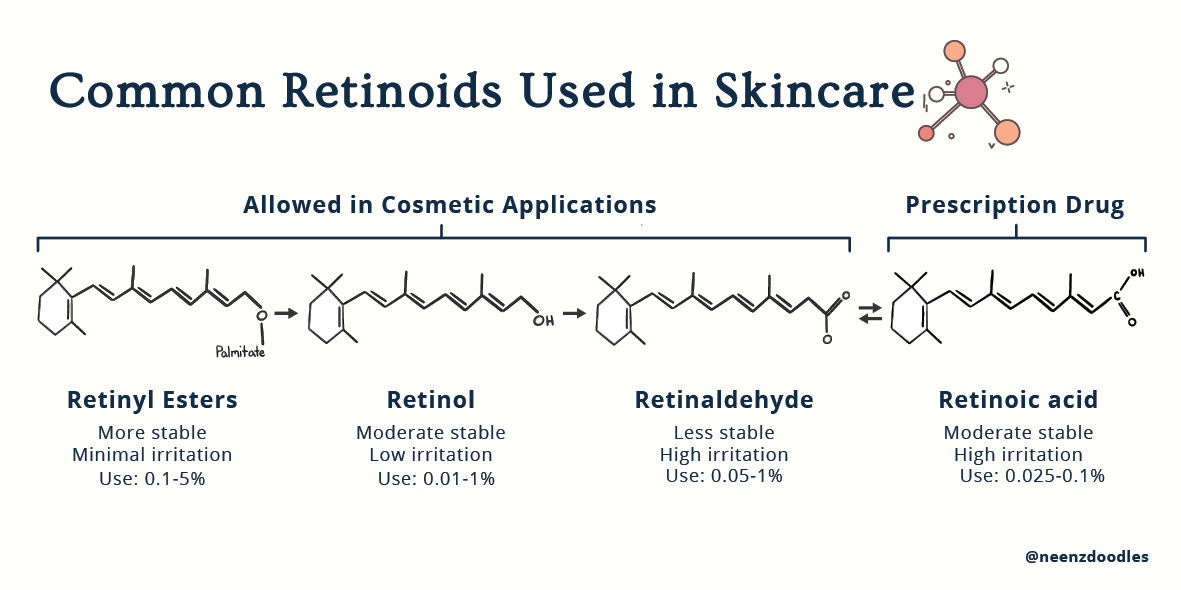Everything You Need to Know About Retinol: Part 1
Retinol (another term for Vitamin A) is to beauty as a quantum leap is to modern physics – brilliant and game changing. Just as electrons can travel outside the confines of time, it’s almost as if Retinol operates in a similar fashion, accelerating cell turnover at lightning speed and endowing us with the skin of our dreams. But while results can sometimes be too good to be true, we can’t sidestep the “retinol uglies,” and the fact that there is so much confusion around this skincare hero.
Recently, there’s been chatter within the beauty community that an anti-retinol movement is upon us, especially with Bakuchiol being marketed as a retinol alternative. The truth of the matter is, there is no analogous alternative to retinol (that isn’t a retinoid)...not yet at least.
We also have brands and marketers playing the numbers game, implying that higher percentages of retinol are more effective when that’s not necessarily the case, or claiming that they have stabilized retinol. Last we checked, the market stabilized retinol decades ago. And we can’t ignore claims like natural or vegan retinol, which adds to the confusion.
So, we’re here to set the record straight, (first fragrance, now retinol) and help shed some light on this mystifying molecule, how it works, it’s unique history, safety profile, the complexity of retinol-based formulation and how not all retinoid products are created equal. Curious to know what the most effective products on the market may be? Stick with us here, it’s going to get interesting.
First things first: Retinol & Retinoids...are we talking about the same thing?
To bring it back to the basics, Retinoids is the umbrella term for all Vitamin A derivatives, including Retinol. It’s just one of the many types of retinoids out there. The most common derivatives, which you’re probably already familiar with, include: Tretinoin (retinoic acid), Retinaldehyde (also known as Retinal), Retinol, and Retinyl Esters like Retinyl Palmitate and Retinyl Propionate. Then we have a new kid on the block called Retinoic Acid Ester, which you’ll find in the form of Retinyl Retinoate or Hydroxypinacolone Retinoate a.k.a. Granactive Retinoid. The important thing to keep in mind is that each derivative varies in terms of functionality (more on this below) and inherent stability.
As a class of fat-soluble compounds, retinoids are lipophilic – in other words, they love oil. While retinoids can be found in nature or animals, they’re synthesized in a lab for cosmetic application (a bit more on this in part 2). Now, moving on to an important question...how do retinoids work their magic? Let’s review.
Mechanism of action of retinoids
Did you know the genius of retinol lies in its ability to “switch on” in the skin after it is applied? Retinol goes on the skin in an inert form, but once it penetrates the stratum corneum and reaches the cytosol of skin cells, it becomes active. It then binds to retinoic acid receptors in cells and converts what it needs into retinoic acid, ultimately influencing gene expression.
The longer the conversion process to retinoic acid, the less anti-aging benefits you will reap. But on the flip side, you’re likely to experience less irritation, erythema (redness), or contact dermatitis with retinoids that take longer to convert. Let's take a look at a few quick examples. Retinaldehyde is an immediate precursor for retinoic acid, thus converts in one single step. Retinol, on the other hand, goes through a two-step oxidation process to become retinoic acid, while retinyl palmitate takes three steps to convert.
As a reminder, because retinoids are fat soluble and are extremely small in molecular weight, they can penetrate the epidermis and make their way into the dermis. In the process, they stimulate the cellular activity (and proliferation) of keratinocytes, fibroblasts (a type of cell that makes collagen), melanocytes and Langerhans cells (cells that protect us from pathogens).
Consistent retinoid use can strengthen the epidermal protective function, reduce TEWL (trans-epidermal-water loss), and protect against the degradation of our precious collagen and the skin’s entire connective tissue network composed of collagenous and non-collagenous components, known as the extracellular matrix. A common myth that has been busted is that retinol thins your skin. Au contraire my friend, it encourages epidermal hyperplasia or epidermal thickening. Ultimately, this can manifest as increased clarity and brightness of skin, a more even skin tone and minimized fine lines/wrinkles.
The man behind the crown jewel of your skincare routine: Dr. Albert Kligman
Now that we got some of the basics out of the way, let’s move on to talk about the man who paved the way for clearer, brighter, and more even skin. You might be thinking, why is this important? Well, if you learn the history, you’ll appreciate much more what a tremendous discovery retinol is for the beauty industry.
While the chemical makeup of Vitamin A was first identified in 1931 by chemist Paul Karrer, it wasn’t until the 1960s when a dermatologist by the name of Dr. Albert Kligman took tretinoin under his wings and became the first person to identify the right dosage/formulation – one that wasn’t too sensitizing or irritating for the skin.
Kligman’s discovery was licensed to Johnson & Johnson and was introduced as Retin-A in 1971 as a prescription-strength treatment for acne. This advancement was a boon for dermatologists and soon after Retin-A was approved, patients noticed that it wasn’t just their breakouts that had improved. They also saw a reduction in fine lines, wrinkles and hyperpigmentation. It wasn’t until the mid 80s, however, when the efficacy of tretinoin as an anti-aging superstar was proven by Kligman and his team.
Dr. Kligman was also the man who debunked the myth that eating chocolate worsens acne, authored hundreds of scientific papers on various skin maladies, and spent over 50 years as a lauded professor at the University of Pennsylvania. But while Kligman had numerous achievements under his belt, he’s also remembered for conducting unethical, skin-related (and other) experiments on inmates (predominantly African American) in a PA prison.
Fast forward to today, tretinoin is the most researched retinoid out there in the treatment of intrinsic aging or photoaging. It’s a veritable hero, unlike no other, when compared to the shiny, new ingredients that have forayed into the anti-aging scene.
Now that we’ve set the context for retinol, stay tuned for part 2 where we’ll be diving into regulations and safety, how chemists approach retinol-based formulation, and most importantly, why all retinol products are not created equal. Plus, an overview of some retinol products that may just tick all the boxes in terms of efficacy.
Cover Photo by Jess @ Harper Sunday on Unsplash



